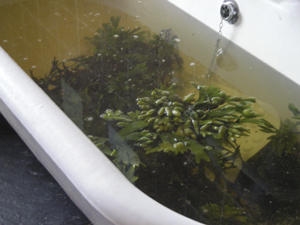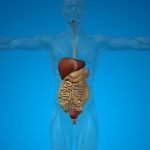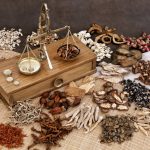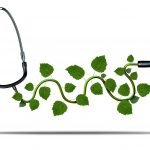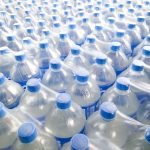The Delicate Balance of Iodine in Thyroid Health
Effects on Functional Metabolism and Applications to Achieve Balance
Kristina Conner, ND
Iodine is the master nutrient for the thyroid, but it is somewhat temperamental. The larger problem worldwide is iodine deficiency, yet toxic levels can be reached through environmental exposures and everyday foods. Iodine supplementation needs to be delicately balanced, especially in those who were previously deficient, to avoid affecting the thyroid gland adversely. Given the lack of quality information on the subject available to the average person and the wide availability of potentially damaging foods and over-the-counter supplements, it is no surprise that many patients seek naturopathic care for thyroid conditions. What information can we provide to patients about iodine that is not merely speculative and might affect their thyroid condition or prevent one? The goal of this article is to answer common questions on the subject.
What Is the Optimal Level of Iodine?
The World Health Organization defines iodine deficiency as urine iodine excretion under 100 µg/L1, but intakes to maintain that range can vary. The highest iodine intake is in Japan, estimated to be 1 to 3 mg/d.2 The mean daily iodine intake in a Korean study3 of adults was 479 µg/d, above average for intake, with higher urinary iodine excretion as well. A review of British diets found that milk, fish, edible seaweed, and kelp supplements provided a mean iodine intake above deficiency levels but below 1000 µg/d.4
What Are the Best Absorbed Types of Iodine?
Iodine-enriched salt and water are the main added forms of iodine in diets. Seafoods, dairy products, and edible seaweeds are the most common naturally occurring iodine-rich foods. Kelp is highest in iodine compared with Porphyra species (nori and laver), Undaria pinnatifida (wakame), and Palmaria palmata (dulse),5,6 but iodine content depends on growing conditions. The best evidence for this is Laminaria digitata (kelp), the only plant that can accumulate iodine as the thyroid can. The ability of kelp to uptake iodine is dependent on the environment in which it grows.7 In the future, direct iodine fortification of additional foods may be possible, as well as lowering the goitrogenic activity of foods like brassicas and cassava to affect iodine effectiveness.
Is It Possible to Maintain Iodine Balance Through “Normal” Foods and Iodized Salt?
The short answer is yes; we seem to be able to avoid many thyroid issues with current practices. The 2005-2006 and 2007-2008 National Health and Nutrition Examination Survey data8 show that most Americans are iodine sufficient.So, it does not appear that eating seaweeds or significant amounts of seafood is necessary to maintain thyroid health, which may be reassuring for some patients. A Cochrane review9 found that the use of iodized salt was effective in assuring iodine sufficiency, reduced goiter in some cases, and had no significant adverse effects.
A special concern is pregnancy, especially for women starting with borderline iodine deficiency. In these cases, iodine from salt might be insufficient,10 which means that other sources might need to be added. Among the general public, however, there is a legitimate concern that long-term iodine intake, particularly when it is high but still below toxic levels, might actually induce thyroid autoimmune reactions. Because both Hashimoto disease and Graves disease are the predominant types of thyroid disorder seen in countries without significant iodine deficiency, it is a possible concern for many patients. In a Japanese study,11 high intake of kombu seaweed (15-30 g/d) caused thyroid suppression, which was reversible when iodine intake was lowered. Moderate to high consumption of seaweed has also been associated with increased risk of papillary thyroid carcinoma.12 There are reported toxicity cases related to consumption of soy milk processed with kombu and ingestion of seaweed soup13; although these appear to be rare, it is notable that one can achieve toxic levels exclusively through food intake. Given that there is much more unknown, we are left with an area ripe for discussion with patients.
What Foods or Nutrients Compete With Iodine Absorption?
Dietary goitrogens such as thiocyanides must be accounted for when assessing the effect of iodine intake, especially with multiple goitrogens in staple foods and little dietary variety. However, the effect of these goitrogenic compounds may be relevant only when iodine deficiency occurs. For instance, in Cameroon, known for iodine-deficient soils, a lack of seafoods, and intake of thiocyanide-rich cassava, there is high risk for goiter formation,14 and the same appears to hold true for bromide. When bromide is consumed (from seaweeds or other foods) and iodine intake is deficient, thyroid hormone production may be inhibited by bromide binding in place of iodine.15
Perchlorate, commonly found in soil and groundwater from natural sources and from environmental contamination, is well known to inhibit iodine transport. Yet, when perchlorate naturally occurs in seaweeds, the iodine content is high enough to compensate, and no adverse effects are seen from the perchlorate itself. Inhibitory effects of nitrates and thiocyanates from food or water are more pronounced.15 While removing unnecessary environmental sources of perchlorate still makes sense to protect future thyroid health, it appears that removing dietary goitrogens may be less critical than ensuring adequate iodine status.
High intake of soy foods is also thought to promote thyroid dysfunction, and it does so in cases of iodine deficiency or possibly with high intake of other goitrogens. In a small study,16 postmenopausal women without thyroid disorders were supplemented with both seaweed and soy protein isolate. Soy did not change thyroid hormone production, but seaweed mildly increased thyrotropin levels.
How Should One Consume Iodine-Rich Foods?
Traditional food preparations such as soups can improve iodine uptake but result in lower iodine content. This might be the case in dried seaweeds as well, which are boiled before drying. In cases where iodine toxic effects are a concern, the lower amount of iodine can be advantageous, as can certain food combinations. In Japan, seaweeds are often eaten with foods such as brassica vegetables and soy, which may prevent excessive iodine uptake.2
Nutrients such as selenium also affect iodine activity, so intake should be optimal for thyroid health. Selenium is depleted in many soils worldwide, and the use of phosphate-based fertilizers decreases the concentration and bioavailability of selenium from the soil. Selenium fortification in cereals or salt might be one way to boost levels, as well as direct application, soil enrichment, or fertilizer amendment.
How Else Can We Obtain Iodine Besides Consuming Food and Supplements?
Living near the sea in a seaweed-rich area may provide some iodine. Urine iodine excretion was found to be higher in children who lived in seaweed-abundant coastal areas compared with those living in inland or coastal areas having low amounts of seaweed.17
Salt caves might provide this benefit, but most research has focused on sodium chloride for respiratory illnesses rather than for thyroid disorders. It is uncertain whether the iodine content naturally occurring in the salt blocks would have the same effect as dietary intake.
Another possible source of iodine is topical application of seaweed or sea products. Seaweed baths using Fucus species, popular until the early 20th century, are available in some seaside areas such as west Ireland18 (Figure). Thalassotherapy is commonly seen in modern spas as wraps, baths, masks, and scrubs. Because most of these treatments use prepared seaweed preparations rather than raw seaweed, which can have more variable iodine content, it is a therapy that could be evaluated for its effect as an iodine delivery method.
Take-Home Point
In reviewing these questions, an important take-home point emerges: we need to look at whole dietary history and environmental exposures to assess the risk for iodine-related thyroid disorders. We typically do this in naturopathic medicine, but it confirms our approach. The patient with low iodine and high goitrogen intake has a different risk level than the patient with an iodine-excessive diet, even if both are healthy. We continue to investigate the ideal iodine balance to help direct patients to safe, effective practices to maintain thyroid health.
 Kristina Conner, ND graduated from St John’s College (Annapolis, New Mexico) and Bastyr University (Kenmore, Washington). She completed her residency in family and integrated medicine at the University of Bridgeport College of Naturopathic Medicine (Bridgeport, Connecticut). After her residency, she continued at Bridgeport, serving as a clinical faculty member and as clinic coordinator. Dr Conner had a naturopathic medicine practice in Indiana before joining the faculty at National University of Health Sciences in Lombard, Illinois, where she is currently an associate professor of clinical sciences. Dr Conner teaches courses in hydrotherapy, naturopathic medicine, and nutrition.
Kristina Conner, ND graduated from St John’s College (Annapolis, New Mexico) and Bastyr University (Kenmore, Washington). She completed her residency in family and integrated medicine at the University of Bridgeport College of Naturopathic Medicine (Bridgeport, Connecticut). After her residency, she continued at Bridgeport, serving as a clinical faculty member and as clinic coordinator. Dr Conner had a naturopathic medicine practice in Indiana before joining the faculty at National University of Health Sciences in Lombard, Illinois, where she is currently an associate professor of clinical sciences. Dr Conner teaches courses in hydrotherapy, naturopathic medicine, and nutrition.
References
de Benoist B, et al. eds. Iodine status worldwide. WHO Global Database on Iodine Deficiency, World Health Organization, 2004.
Zava TT, Zava DT. Assessment of Japanese iodine intake based on seaweed consumption in Japan: a literature-based analysis. Thyroid Res. 2011;4:14. http://www.ncbi.nlm.nih.gov/pmc/articles/PMC3204293/?tool=pubmed. Accessed June 14, 2012.
Kim JY, Moon SJ, Kim KR, Sohn CY, Oh JJ. Dietary iodine intake and urinary iodine excretion in normal Korean adults. Yonsei Med J. 1998;39(4):355-362.
Lee SM, Lewis J, Buss DH, Holcombe GD, Lawrance PR. Iodine in British foods and diets. Br J Nutr. 1994;72(3):435-446.
Teas J, Pino S, Critchley A, Braverman LE. Variability of iodine content in common commercially available edible seaweeds. Thyroid. 2004;14(10):836-841.
Watanabe F, Takenaka S, Katsura H, et al. Dried green and purple lavers (nori) contain substantial amounts of biologically active vitamin B12 but less of dietary iodine relative to other edible seaweeds. J Agric Food Chem. 1999;47(6):2341-2343.
Martinelango PK, Tian K, Dasgupta PK. Perchlorate in seawater: bioconcentration of iodide and perchlorate by various seaweed species. Anal Chim Acta. 2006;567(1):100-107.
Caldwell KL, Makhmudov A, Ely E, Jones RL, Wang RY. Iodine status of the U.S. population, National Health and Nutrition Examination Survey, 2005-2006 and 2007-2008. Thyroid. 2011;21(4):419-427.
Wu T, Liu GJ, Li P, Clar C. Iodised salt for preventing iodine deficiency disorders. Cochrane Database Syst Rev. 2002;(3):CD003204.
Marco A, Vicente A, Castro E, et al. Patterns of iodine intake and urinary iodine concentrations during pregnancy and blood thyroid-stimulating hormone concentrations in the newborn progeny. Thyroid. 2010;20(11):1295-1299.
Miyai K, Tokushige T, Kondo M; Iodine Research Group. Suppression of thyroid function during ingestion of seaweed “Kombu” (Laminaria japonoca) in normal Japanese adults. Endocr J. 2008;55(6):1103-1108.
Michikawa T, Inoue M, Shimazu T, et al; Japan Public Health Center–Based Prospective Study Group. Seaweed consumption and the risk of thyroid cancer in women: the Japan Public Health Center–Based Prospective Study. Eur J Cancer Prev. 2012;21(3):254-260.
Crawford BA, Cowell CT, Emder PJ, et al. Iodine toxicity from soy milk and seaweed ingestion is associated with serious thyroid dysfunction. Med J Aust. 2010;193(7):413-415.
Taga I, Oumbe VA, Johns R, Zaidi MA, Yonkeu JN, Altosaar I. Youth of west-Cameroon are at high risk of developing IDD due to low dietary iodine and high dietary thiocyanate. Afr Health Sci. 2008;8(3):180-185.
Romarís-Hortas V, Moreda-Piñeiro A, Bermejo-Barrera P. Microwave assisted extraction of iodine and bromine from edible seaweed for inductively coupled plasma-mass spectrometry determination. Talanta. 2009;79(3):947-952.
Teas J, Braverman LE, Kurzer MS, Pino S, Hurley TG, Hebert JR. Seaweed and soy: companion foods in Asian cuisine and their effects on thyroid function in American women. J Med Food. 2007;10(1):90-100.
Smyth PP, Burns R, Huang RJ, et al. Does iodine gas released from seaweed contribute to dietary iodine intake? Environ Geochem Health. 2011;33(4):389-397.
Seaweed Site. Information on marine algae. http://www.seaweed.ie/baths/index.html. Accessed May 5, 2012.



